Stopping an Atomic Duck
Braking performance is very important for safety and ensuring the vehicle is controllable. For best practice, a brkaing system should:
-
allow easy operation for normal use to slow and stop the vehicle.
-
be immediately accessible to in an emergency, and bring the vehicle to rest in the shortest distance possible.
-
allow greater braking forces on the leading axle, with less braking at the rear to prevent skidding/jack-knifing.
-
allow braking adjustment left/right across an axle to maximise brake performance and minimise steering reactions.
-
not interfere or hinder the operation of any other controls.
-
be able to be set “on” to stop the vehicle from rolling when stopped or parked.
To achieve these aims, Atomic Duck will have brakes on all three wheels and will include a handbrake (parking brake).
Three-Wheel Braking
The front brakes will always be the most important on a vehicle, because forward weight transfer during braking increases the vertical load on those tyres and means (typically) 60-70% of the braking effort is done with the leading axle for maximum deceleration.
The exact distribution depends both on the weight distribution of the vehicle and the deceleration of the vehicle, but for a short wheelbase tadpole trike, that figure might be 85-100% of braking performance on the front wheels. 100% being when there is no weight on the rear wheel, and the trike just begins to tip forwards.
This is similar for bicycles and motorbikes: maximum braking occurs when all the weight is over the front axle, when the rear tyre seems to float on the road surface (because any more braking would tip the rider over the handlebars). In MotoGP racing, front brake pads are changed every weekend (~300miles), but the rear set lasts the whole season (18 races plus practice and qualifying).
This extremely heavy front braking balance, and having only two brake levers and three wheels, is probably why many trike builders forgo the rear brake in favour of having independently braked front wheels. In this situation, omitting the rear brake has only a small reduction in actual braking performance, but allows the rider to adjust the left/right balance in the same manner as the ABS/Anti-Spin controller on a modern car can do.
Because of the rearward weight distribution of the Atomic Duck (around 40%/60%–front/rear), a significant proportion of the maximum braking performance comes from the rear wheel. Omitting a rear wheel brake would reduce the maximum braking by up-to 40%–much larger than 15% for a swb trike.
Including the rear brake means a bicycle-style front brake/rear brake lever combination could be used, but this removes the advantage of a left/right split and controlling the braking of the front two wheels independently.
Instead, because the rear brake need only be used when maximum braking force is needed, Atomic Duck will have two hand-brake levers on the steering wheel for the front wheels and a foot brake, operating on the rear wheel, next to the pedals to allow full braking force in an emergency.
Front-Axle Brake Bias
With two brake levers on the steering wheel, operating the brakes on the front two wheels, there are a number of ways to connect the levers with the brakes. The most straight forward is to connect the front left lever to the front left brake, and the right lever to the right brake; but because Atomic Duck will have a steering wheel that rotates, the rider might only reach one of the levers to slow the velomobile while turning sharply.
Because the rider will remove their hands from the levers for some corners, a brake bias linkage could allow each lever to operate both wheel brakes, but exert a different braking force on the left and right wheels.
This gives the following options:
-
Separate operation–left-to-left and right-to-right: both levers must be used at the same time.
-
Preferential operation–most force is transfered to the same-side brake, but a small proportion operates the other. This way, minimal braking can be performed with one lever, but full performance and variation of the left/right balance need both.
-
Equal operation–half the force is transmitted to each brake. Here, the brakes can be operated identically with either lever, but there is no adjustment for the left/right balance (this could be simplified to a single lever).
Each option has its merits, and I’m not sure which will be best in practice, so I’ll initially be using a brake bias linkage that allows each possibility, depending on how it is connected. That way, I can test all of them.
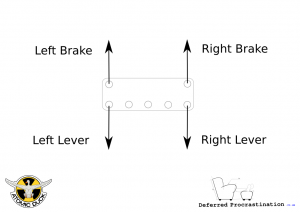 Separate brake bias linkage
Separate brake bias linkage
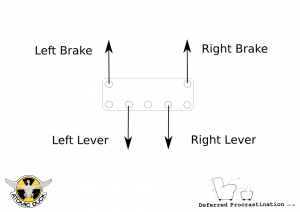 Preferential brake bias linkage
Preferential brake bias linkage
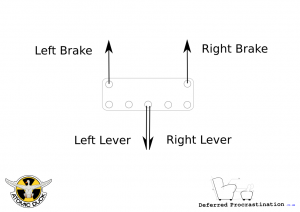 Equal-force brake bias linkage
Equal-force brake bias linkage
Handbrake (Parking-brake, e-brake)
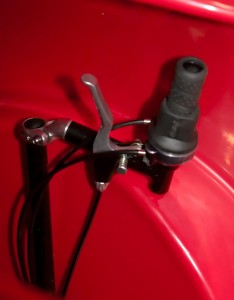 Right side steering in a TriSled Rotovelo
Right side steering in a TriSled Rotovelo
Because trikes don’t get laid down, have a kick-stand or get leaned against things, they need some kind of braking mechanism that can be left on, to stop them rolling away when they are stopped or parked.
The main method I found so far is to use a strap to keep one of the brake levers pressed without the rider. I’ve seen some manufacturers sell Velcro straps as accessories for trikes–presumably because human powered vehicles are lighter than cars, much easier to stop rolling by hand (or foot), and have to be secured to something else when left; a handbrake is not seen as a necessary part.
One recent innovation that seems to go further, is the integration of a button into the brake lever that locks the lever when the button is pressed. As seen on the new TriSled Rotovelo prototypes.
The Atomic Duck will have a mechanism more like a car, where a lever at the side of the rider operates the same rear brake calliper as the foot brake, with a ratchet to keep the tension on the brake.
I particularly want to remove the handbrake operation from the brake levers, and make it easier to use. With a separate lever, the rider can slow and stop with the normal brakes (including, or not, the rear foot brake) and hold the velomobile stationary with either one hand or foot while putting on the handbrake.
This stops any fiddling with a two handed operation to use both a brake lever and a strap; a situation that seems particularly difficult if the vehicle was pointing nose downhill, when the pedals can’t be used to keep it stationary.
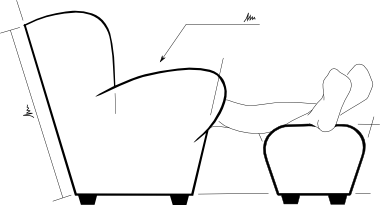
Patrick Fenner wrote, “Has you had any experience driving/riding low weight vehicles with front wheels that are independently braked or braked equally? Did independent braking give better control? Is brake balance intuative? Do you prefer combined or independent braking?”